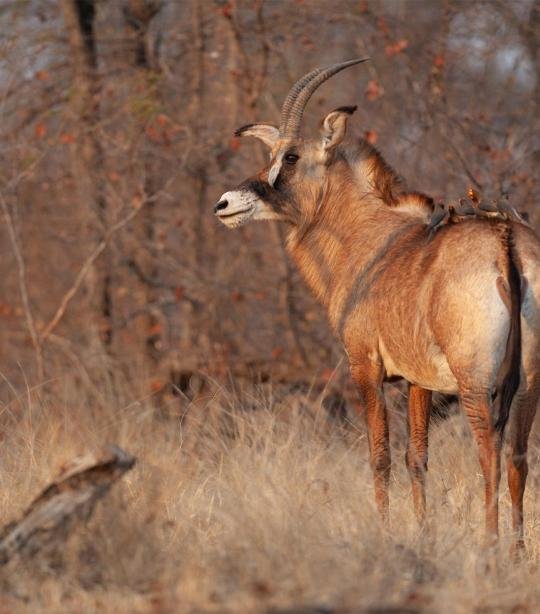
The roan antelope, known for its striking color and impressive horns, typically resides in the savannas of Africa. These animals are not just pretty faces; they’re equipped with heavy-duty defenses that can surprise anyone who underestimates them. So, can the roan antelope be dangerous to humans? Here, we’ll break down their behavior, the potential risks involved, and why understanding them is crucial for anyone who spends time in their habitat.
Understanding the Roan Antelope’s Behavior
Roan antelopes are social animals, often found in groups that can range from a few individuals to larger herds. They have a structured social system, with dominant males overseeing the group. Honestly, this social dynamic plays a crucial role in how they interact with their environment and other species, including humans.
These animals are primarily herbivores, feeding on grasses, leaves, and other vegetation. They’re known for their keen eyesight, which helps them detect predators from afar. Here’s the thing: while they are typically shy and avoid human contact, they can be protective of their territory and companions. If they feel threatened, they may respond aggressively.
It’s important to note that roan antelopes have a unique form of defense—those impressive horns aren’t just for show. Males possess long, curved horns that can be used effectively against attackers. This detail plays a key role in understanding whether roan antelope can be dangerous to humans.
When Do Roan Antelopes Become Aggressive?
In general, roan antelopes prefer to keep their distance from humans. However, several factors can trigger aggressive behavior. One common scenario is when they feel cornered—like any animal, a roan antelope will defend itself if it feels there’s no way out.
For instance, if you find yourself too close to a roan antelope in the wild—especially during breeding season or while they’re caring for young ones—you might notice a sudden change in their demeanor. They could exhibit signs of aggression, such as charging or trying to butt you with those formidable horns.
Additionally, males may display aggressive behavior during fights for dominance within their herd. This means that if you’re in the wrong place at the wrong time, you could unintentionally get caught in a conflict. It’s a reminder to respect their space and observe from a distance whenever possible.
Comparing Roan Antelope with Other Wildlife
When discussing wild animals, it’s helpful to compare them with others to understand their behaviors better. For instance, consider how roan antelopes stack up against other herbivores like zebras or wildebeests.
While zebras are known to kick and bite when threatened, roan antelopes utilize their horns as weapons. Wildebeests, on the other hand, tend to flee rather than confront. This difference is crucial in understanding how each animal might react to human presence. Knowing this can help you prepare for encounters with wildlife in their natural habitats.
In short, while roan antelopes may not exhibit overt aggression like some other species, their defensive capabilities and social behavior make them unique. If you spot one, enjoy the view but keep your distance—you’ll have a much safer experience.
How to Stay Safe Around Roan Antelopes
If you ever find yourself in an area inhabited by roan antelopes, there are a few guidelines to keep in mind. First and foremost, always maintain a safe distance. You might be tempted to snap a close-up photo, but giving these animals space is crucial.
Here are a few tips to help you stay safe:
- Observe from afar: Use binoculars or a zoom lens to enjoy their beauty without approaching too closely.
- Stay calm: If you encounter a roan antelope, avoid sudden movements that might startle them.
- Educate yourself: Learn about their behavior and habitat before visiting an area where they’re commonly found.
By following these simple guidelines, you can minimize the risk of an aggressive encounter. Remember, these animals are primarily concerned with their own safety and the security of their herd.
The Role of Conservation in Roan Antelope Safety
Understanding the potential dangers roan antelopes pose to humans brings us to another crucial point—conservation. As habitats shrink due to human encroachment and climate change, roan antelopes may find themselves in precarious situations. This leads to more frequent human-animal interactions, which can elevate risks for both parties.
Conservation efforts play a vital role in protecting these creatures and their habitats. By preserving natural spaces, we can reduce the chances of dangerous encounters. Plus, healthy animal populations can thrive without feeling threatened by human activity.
Organizations dedicated to wildlife conservation often have educational programs that help inform the public about the importance of respecting wildlife. Engaging with these initiatives can provide you with valuable insights and promote coexistence.
So, can the roan antelope be dangerous to humans? The answer is nuanced. While they don’t actively seek confrontation, their protective instincts can lead to aggressive behavior if they feel threatened. Understanding these animals means recognizing their boundaries.
By respecting their space and following safety guidelines, you can enjoy the beauty of the roan antelope without unnecessary risks. Wildlife shares this planet with us, and with a little knowledge and respect, we can coexist peacefully. Next time you think about this magnificent creature, remember to admire its grace from a distance and appreciate the wild world we’re all part of.

